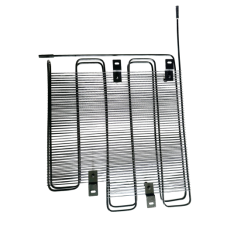Wire-tube condensers have a rich history dating back to the early 20th century when they revolutionized refrigeration technology. Today, their efficiency and compact design make them indispensable in modern appliances. In this post, we'll explore the inner workings of wire-tube condensers, their applications across different industries, and their impact on energy efficiency. So, if you've ever wondered about the magic behind keeping your drinks cold or your room comfortable, stick around as we uncover the fascinating world of wire-tube condensers.

First, let's understand how the wire-tube condenser works. The wire tube condenser operates on the principle of heat exchange. As the hot vapor refrigerant flows through the wire tubes, it comes into contact with the cooler air outside. This contact causes the vapor to release its heat energy, transforming it into a liquid state. This process occurs due to the difference in temperature between the hot refrigerant inside the tubes and the cooler air surrounding them. The transfer of heat from one medium to another is what enables wire tube condensers to convert vapor into liquid efficiently.
Refrigerants play a crucial role in wire tube condenser operation. These substances are responsible for absorbing heat from their surroundings when they change from liquid to gas form within an evaporator. Once they reach the wire tube condenser, they release this absorbed heat as they transition back from gas to liquid state.
For instance, consider a refrigerator's wire tube condenser: when warm air inside meets cold refrigerant-filled tubes, it causes a phase change in which refrigerant vapors turn back into liquids by releasing their stored thermal energy. This transformation allows for efficient cooling and keeps food fresh.
Steam is an important energy carrier in many industrial production processes. By using wire-tube condensers, factories can recycle steam during the production process, thereby reducing energy waste. For example, in chemical plants, steam is usually used to heat reactors or provide power, while wire-tube condensers can quickly condense the reacted steam into a liquid state and transport it to the reactor again, realizing energy recycling and improving energy efficiency.
In addition, wire-tube condensers also play an important role in air conditioning and refrigeration systems. In these systems, a wire-tube condenser is used to cool the refrigerant, convert it from a gaseous state to a liquid state, and then transport it to the evaporator for circulation, thereby achieving the effect of air conditioning or refrigeration. By optimizing the design of the wire-tube condenser and selecting efficient refrigerants, the energy consumption of air conditioning and refrigeration systems can be reduced and energy efficiency improved.
In addition to industrial and commercial areas, wire-tube condensers also play an important role in energy production. For example, in thermal power plants, steam is the power source to drive turbine generators, and the wire-tube condenser is used to condense the hot steam discharged from the turbine into the water and then transport it to the boiler again for recycling. By optimizing the wire-tube condenser design and operating parameters, the energy conversion efficiency of the power plant can be improved, fuel consumption reduced, and environmental pollution reduced.
In general, wire-tube condenser, as an important heat exchange device, has an important impact on energy efficiency. By optimizing design and operating parameters, wire-tube condensers can play an important role in industrial production, air conditioning and refrigeration, energy production and other fields, reducing energy waste and improving energy utilization efficiency. In the future, with the continuous advancement and innovation of science and technology, it is believed that wire-tube condensers will play a more important role in the energy field and make greater contributions to energy conservation and environmental protection.
https://www.ningbo-senjun.com/Impact-and-application-analysis-of-wire-tube-condenser-on-energy-efficiency.html
mia
Lon@ningbo-senjun.com

